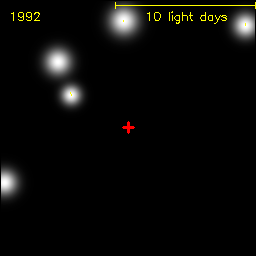
In some galaxies the central region is observed to outshine all the billions of stars in the galaxy itself. The spectrum is not like that observed from stars and the emission is observed to be bright at all wavelengths. The luminosity varies on very short timescales, less than a day, and this means that the size of the central region is less than one light-day across (six times the distance from the Sun to Neptune). The most efficient conversion of matter to energy is the accretion by a black hole, which works around 10%, and so we infer that it is a Super Massive Black Hole (SMBH) which is causing the emission.
The high energy and radio emission is direct, coming from the central regions around the black hole itself. In the optical and infra-red wavebands the emission is not direct - the light has been absorbed and then is re-radiated (possibly at a new wavelength) by clouds of gas and dust which surround the central "engine."
There are a whole menagerie of AGN, depending on their brightness and the classification schemes used have been built up over the years and so are sometimes confusing. The lower luminosity AGN are called Seyfert Galaxies (and there are two types of these) and Radio Galaxies. The more powerful AGN are called Quasars (from Quasi-Stellar Objects or QSO as they looked like stars in early telescopes), blazars and BL Lac's. Not all AGN are strong radio sources, but many are, and they were discovered because they were radio bright objects which looked like stars but were at much larger distances. As they are so bright that they can be seen across the Universe they are a useful cosmological tool to measure the evolution of the Universe.
The Milky Way contains a super massive black hole which is as massive as ~ 1 million Suns. However we don't see it as being very bright - it is not an Active Galactic Nucleus. The reason for this is that it is currently not accreting anything. Astronomers know that the black hole is there because stars are seen orbiting around an invisible mass very fast, which means that it is very heavy.
 |
| A set of images of the centre of the Milky Way showing the motions of stars around the Black Hole. Image courtesy MPE, Garching |
Most (~90%) of AGNs are radio quiet and many are also obscured. This means that they have large amounts of gas and dust around them which blocks large amounts of the light they emit. AGNs are variable on very short timescales which means that they themselves are very small, as the largest size they can be is limited by the time taken for light to cross them.
BACK: Cosmology with Clusters UP: X-ray Research Topics NEXT: AGN & Black Holes